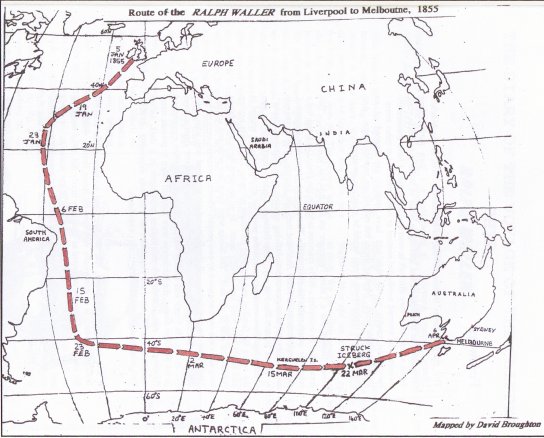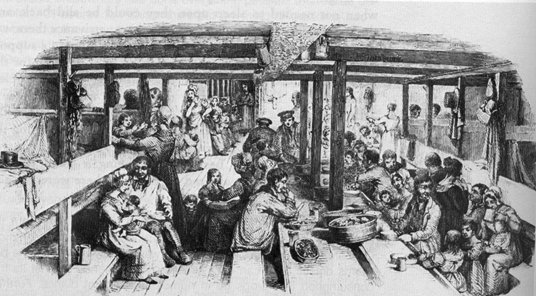The VOYAGE out |
|
The ships at that time touched no land between England and Melbourne as they travelled in what is called the great circle. |
|
|
|
Although on a flat projection map this looks a longer distance, because it is following the curvature of the Earth, it is actually the shortest distance between the two points. It begins by heading west out into the Atlantic as if going to America, making use of the trade winds and after crossing the Equator gradually curving east. The route took them far south into the Antarctic Ocean to get the best winds to take them east but the weather was usually very fierce and freezing cold. After first enduring the intense heat of the tropics, where it was difficult to maintain any sort or comfort either on deck or below deck, dressed, as they were, in totally unsuitable clothes, they were then subjected to the intense cold of the Antarctic. Ships had cabins for the privileged few but the bulk of the passengers travelling to Australia would have had much more primitive accommodation. The accommodation was in a converted ship's hold. This was divided into three sections with bulkheads between them. The single men were in the front or forward section, the middle section was for families where there were children under fourteen years of age and the back or aft section was for the single women, well separated from the single men (no hanky panky was tolerated on these ships). All were very cramped quarters. In the centre of each section there was a long table where everyone ate their meals, wrote letters, sewed or did anything else that was done at a table. Some were chosen from their number whose job it was to collect the meals from the galley, where it was cooked, to bring to the table. Each passenger had their own plates and cutlery and was responsible for keeping them clean. Water was at a premium so they could only be washed in salt water. This was the only water people could use for washing themselves too. Clothes would not be able to be washed at all. Once a month the passengers' trunks were brought up from the hold so that they could put on a fresh set of clothes and pack away their dirty clothes. On each side of the table were bunk beds. These were six feet long and three feet wide and had to be shared by two people. In the family section this would have been a husband and wife but in the single man and single woman sections they would often be shared by compete strangers. The only light and air for each section came from a hatchway. |
|
|
|
Often, during the bad weather this was battened down and all lights (lamps with naked flames or candles) extinguished for fear of fire. The passengers would have been in complete darkness, tossed about in stormy seas and probably very frightened indeed. In the rough seas many would have been very seasick and there were only very primitive sanitary arrangements. The smell must have been unbearable. Any infection spread very rapidly. Needless to say there were many who did not survive in these conditions. |


